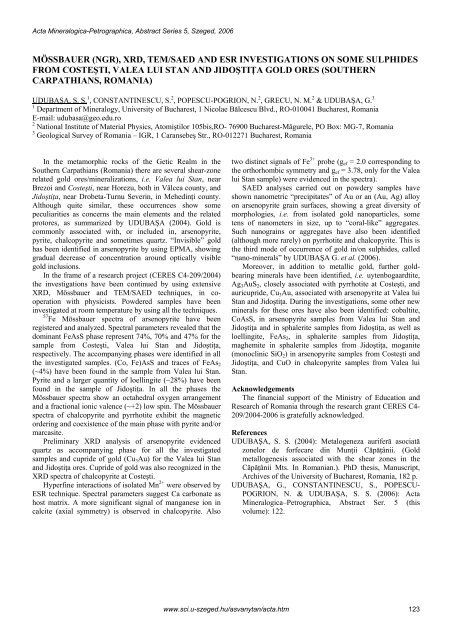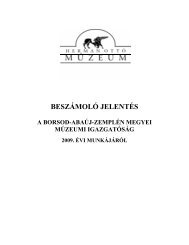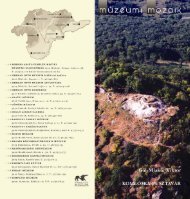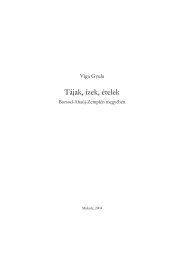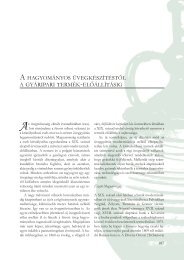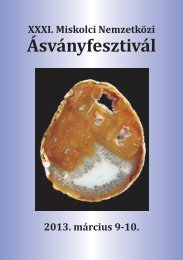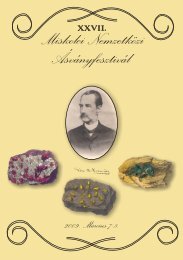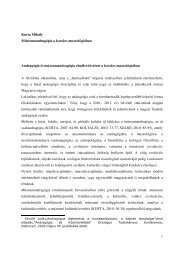Acta Mineralogica-Petrographica, Abstract Series 5, Szeged, 2006NANOMETRIC <strong>IN</strong>CLUSIONS <strong>IN</strong> <strong>M<strong>IN</strong>ERAL</strong>S. AN EPMA, TEM/SAED AND MÖSSBAUER(NGR) APPROACHUDUBAŞA, G. 1 , CONSTANT<strong>IN</strong>ESCU, S. 2 , POPESCU-POGRION, N. 2 & UDUBAŞA, S. S. 31 Geological Survey of Romania – IGR, 1 Caransebeş Str., 012271 Bucharest, RomaniaE-mail: udubasa@geo.edu.ro2 National Institute of Material Physics, Atomiştilor 105bis, 76900 Bucharest-Măgurele, PO Box: MG-7, Romania3 Faculty of Geology & Geophysics, University of Bucharest, 1 Nicolae Bălcescu Blvd., 010041 Bucharest, RomaniaA large number of mineral species (some 4-500 of about4,000 known today) commonly occur as inclusions in otherminerals and their identification needs as a rule moresophisticated equipment. Mineral species, which are knownto occur only as inclusions are called micro-minerals, i.e.micrometer-sized bodies, such as mackinawite in pentlanditeor in polyphase chalcopyrite-dominated inclusions insphalerite. Careful microscopic investigation is commonlysufficient for identification, provided the optical propertiesare different as compared to the host minerals. Furtherexamples: ulvöspinel in magnetite, sometimes valleriite inpentlandite, isocubanite (the former “chalcopyrrhotite”) inchalcopyrite inclusions in sphalerite etc.There are also cases when the microscope cannot helpfurther in establishing the true nature of sub-micrometerinclusions. In such cases EPMA should be used coupled withmicrodiffraction devices. Examples can be given ofnumerous mineral species or compound found in thearsenopyrite from the Costesti gold ores, South Carpatians,Romania. Only by using EPMA sub-micrometer sized gold, aschreibersite-like phase (with Fe > Ni), greenockite andseveral Bi-containing phases have been determined (seeUDUBAŞA, 2004, for details). Such inclusions could becalled “infra-minerals”.A third level of inclusions can be traced at nano-size, i.e.microscopically impossible to be seen and hardly difficult tobe hit. In such cases TEM/SAED seems to be the only way torecover the nano-world of minerals (“nano-minerals”). Twoexamples can by here given: (1) Discovery of wüstite andpyroxferroite as nanoinclusions in manganoan fayalite atRăzoare, Preluca Mts., Romania (CONSTANT<strong>IN</strong>ESCU etal., 2004). These two minerals mark a very early, high PTmineral association during the metamorphic evolution of therock pile. (2) Identification of nanometer-sized inclusions or“precipitates” of gold in or on arsenopyrite, pyrite andchalcopyrite from some shear-zone related ores inmetamorphic rocks of the South Carpathians (for furtherdetails see UDUBAŞA S. S. et al., 2006, abstract in thisvolume). The first level is represented by optically visiblegold inclusions (most frequently seen in arsenopyrite). Thesecond level has been established by extensive use of EPMA:around gold inclusions in arsenopyrite there were measureddecreasing gold contents in apparently homogeneous parts ofarsenopyrite monocrystals (UDUBAŞA & TOPA, 1995;UDUBAŞA, 2004). This is the so-called invisible gold insulphides. The third level of gold occurrence is only possiblyto visualize by using TEM/SAED techniques. In addition togold, a further “nano-mineral” in pyrite from the Costeştigold ores is the rare Ag-Au sulphide, uytenbogaardtite.Note: The financial support of the Romanian Ministry ofEducation and Research in the frame of a research grant (4-209/2004-2006, and that is acknowledged) enabled a closecooperation between mineralogists and physicists and thusthe discovery of the “nano-minerals” in sulphides.ReferencesCONSTANT<strong>IN</strong>ESCU, S., POPESCU-POGRION, N.,UDUBAŞA, G., HARTOPANU, P. & REDFERN, S.T.(2004): Romanian Journal of Physics, 49: 631–640.UDUBAŞA, G. & TOPA, D. (1995): Romanian Journal ofMineralogy, 77, Suppl. 1: 47–48.UDUBAŞA, S. S. (2004): Metalogeneza auriferă asociatăzonelor de forfecare din Munţii Căpăţânii. (Goldmetallogenesis associated with the shear zones in theCăpăţânii Mts. In Romanian.). PhD thesis, Manuscript,Archives of the University of Bucharest, Romania, 182 p.UDUBAŞA, S. S., CONSTANT<strong>IN</strong>ESCU, S., POPESCU-POGRION, N., GRECU, N. M. & UDUBAŞA, G.(2006): Acta Mineralogica–Petrographica, Abstract Ser. 5(this volume): 123.122www.sci.u-szeged.hu/asvanytan/acta.htm
Acta Mineralogica-Petrographica, Abstract Series 5, Szeged, 2006MÖSSBAUER (NGR), XRD, TEM/SAED AND ESR <strong>IN</strong>VESTIGATIONS ON SOME SULPHIDESFROM COSTEŞTI, VALEA LUI STAN AND JIDOŞTIŢA GOLD ORES (SOU<strong>THE</strong>RN<strong>CARPATHIANS</strong>, ROMANIA)UDUBAŞA, S. S. 1 , CONSTANT<strong>IN</strong>ESCU, S. 2 , POPESCU-POGRION, N. 2 , GRECU, N. M. 2 & UDUBAŞA, G. 31 Department of Mineralogy, University of Bucharest, 1 Nicolae Bălcescu Blvd., RO-010041 Bucharest, RomaniaE-mail: udubasa@geo.edu.ro2 National Institute of Material Physics, Atomiştilor 105bis,RO- 76900 Bucharest-Măgurele, PO Box: MG-7, Romania3 Geological Survey of Romania – IGR, 1 Caransebeş Str., RO-012271 Bucharest, RomaniaIn the metamorphic rocks of the Getic Realm in theSouthern Carpathians (Romania) there are several shear-zonerelated gold ores/mineralizations, i.e. Valea lui Stan, nearBrezoi and Costeşti, near Horezu, both in Vâlcea county, andJidoştiţa, near Drobeta-Turnu Severin, in Mehedinţi county.Although quite similar, these occurrences show somepeculiarities as concerns the main elements and the relatedprotores, as summarized by UDUBAŞA (2004). Gold iscommonly associated with, or included in, arsenopyrite,pyrite, chalcopyrite and sometimes quartz. “Invisible” goldhas been identified in arsenopyrite by using EPMA, showinggradual decrease of concentration around optically visiblegold inclusions.In the frame of a research project (CERES C4-209/2004)the investigations have been continued by using extensiveXRD, Mössbauer and TEM/SAED techniques, in cooperationwith physicists. Powdered samples have beeninvestigated at room temperature by using all the techniques.57 Fe Mössbauer spectra of arsenopyrite have beenregistered and analyzed. Spectral parameters revealed that thedominant FeAsS phase represent 74%, 70% and 47% for thesample from Costeşti, Valea lui Stan and Jidoştiţa,respectively. The accompanying phases were identified in allthe investigated samples. (Co, Fe)AsS and traces of FeAs 2(~4%) have been found in the sample from Valea lui Stan.Pyrite and a larger quantity of loellingite (~28%) have beenfound in the sample of Jidoştiţa. In all the phases theMössbauer spectra show an octahedral oxygen arrangementand a fractional ionic valence (~+2) low spin. The Mössbauerspectra of chalcopyrite and pyrrhotite exhibit the magneticordering and coexistence of the main phase with pyrite and/ormarcasite.Preliminary XRD analysis of arsenopyrite evidencedquartz as accompanying phase for all the investigatedsamples and cupride of gold (Cu 3 Au) for the Valea lui Stanand Jidoştiţa ores. Cupride of gold was also recognized in theXRD spectra of chalcopyrite at Costeşti.Hyperfine interactions of isolated Mn 2+ were observed byESR technique. Spectral parameters suggest Ca carbonate ashost matrix. A more significant signal of manganese ion incalcite (axial symmetry) is observed in chalcopyrite. Alsotwo distinct signals of Fe 3+ probe (g ef = 2.0 corresponding tothe orthorhombic symmetry and g ef = 3.78, only for the Valealui Stan sample) were evidenced in the spectra).SAED analyses carried out on powdery samples haveshown nanometric “precipitates” of Au or an (Au, Ag) alloyon arsenopyrite grain surfaces, showing a great diversity ofmorphologies, i.e. from isolated gold nanoparticles, sometens of nanometers in size, up to “coral-like” aggregates.Such nanograins or aggregates have also been identified(although more rarely) on pyrrhotite and chalcopyrite. This isthe third mode of occurrence of gold in/on sulphides, called“nano-minerals” by UDUBAŞA G. et al. (2006).Moreover, in addition to metallic gold, further goldbearingminerals have been identified, i.e. uytenbogaardtite,Ag 3 AuS 2 , closely associated with pyrrhotite at Costeşti, andauricupride, Cu 3 Au, associated with arsenopyrite at Valea luiStan and Jidoştiţa. During the investigations, some other newminerals for these ores have also been identified: cobaltite,CoAsS, in arsenopyrite samples from Valea lui Stan andJidoştiţa and in sphalerite samples from Jidoştiţa, as well asloellingite, FeAs 2 , in sphalerite samples from Jidoştiţa,maghemite in sphalerite samples from Jidoştiţa, moganite(monoclinic SiO 2 ) in arsenopyrite samples from Costeşti andJidoştiţa, and CuO in chalcopyrite samples from Valea luiStan.AcknowledgementsThe financial support of the Ministry of Education andResearch of Romania through the research grant CERES C4-209/2004-2006 is gratefully acknowledged.ReferencesUDUBAŞA, S. S. (2004): Metalogeneza auriferă asociatăzonelor de forfecare din Munţii Căpăţânii. (Goldmetallogenesis associated with the shear zones in theCăpăţânii Mts. In Romanian.). PhD thesis, Manuscript,Archives of the University of Bucharest, Romania, 182 p.UDUBAŞA, G., CONSTANT<strong>IN</strong>ESCU, S., POPESCU-POGRION, N. & UDUBAŞA, S. S. (2006): ActaMineralogica–Petrographica, Abstract Ser. 5 (thisvolume): 122.www.sci.u-szeged.hu/asvanytan/acta.htm 123
- Page 1:
MSCC33 rd MINERAL SCIENCES IN THE C
- Page 5 and 6:
Acta Mineralogica-Petrographica, Ab
- Page 7 and 8:
Acta Mineralogica-Petrographica, Ab
- Page 9 and 10:
Acta Mineralogica-Petrographica, Ab
- Page 11 and 12:
Acta Mineralogica-Petrographica, Ab
- Page 13 and 14:
Acta Mineralogica-Petrographica, Ab
- Page 15 and 16:
Acta Mineralogica-Petrographica, Ab
- Page 17 and 18:
Acta Mineralogica-Petrographica, Ab
- Page 19 and 20:
Acta Mineralogica-Petrographica, Ab
- Page 21 and 22:
Acta Mineralogica-Petrographica, Ab
- Page 23 and 24:
Acta Mineralogica-Petrographica, Ab
- Page 25 and 26:
Acta Mineralogica-Petrographica, Ab
- Page 27 and 28:
Acta Mineralogica-Petrographica, Ab
- Page 29 and 30:
Acta Mineralogica-Petrographica, Ab
- Page 31 and 32:
Acta Mineralogica-Petrographica, Ab
- Page 33 and 34:
Acta Mineralogica-Petrographica, Ab
- Page 35 and 36:
Acta Mineralogica-Petrographica, Ab
- Page 37 and 38:
Acta Mineralogica-Petrographica, Ab
- Page 39 and 40:
Acta Mineralogica-Petrographica, Ab
- Page 41 and 42:
Acta Mineralogica-Petrographica, Ab
- Page 43 and 44:
Acta Mineralogica-Petrographica, Ab
- Page 45 and 46:
Acta Mineralogica-Petrographica, Ab
- Page 47 and 48:
Acta Mineralogica-Petrographica, Ab
- Page 49 and 50:
Acta Mineralogica-Petrographica, Ab
- Page 51 and 52:
Acta Mineralogica-Petrographica, Ab
- Page 53 and 54:
Acta Mineralogica-Petrographica, Ab
- Page 55 and 56:
Acta Mineralogica-Petrographica, Ab
- Page 57 and 58:
Acta Mineralogica-Petrographica, Ab
- Page 59 and 60:
Acta Mineralogica-Petrographica, Ab
- Page 61 and 62:
Acta Mineralogica-Petrographica, Ab
- Page 63 and 64:
Acta Mineralogica-Petrographica, Ab
- Page 65 and 66:
Acta Mineralogica-Petrographica, Ab
- Page 67 and 68:
Acta Mineralogica-Petrographica, Ab
- Page 69 and 70:
Acta Mineralogica-Petrographica, Ab
- Page 71 and 72: Acta Mineralogica-Petrographica, Ab
- Page 73 and 74: Acta Mineralogica-Petrographica, Ab
- Page 75 and 76: Acta Mineralogica-Petrographica, Ab
- Page 77 and 78: Acta Mineralogica-Petrographica, Ab
- Page 79 and 80: Acta Mineralogica-Petrographica, Ab
- Page 81 and 82: Acta Mineralogica-Petrographica, Ab
- Page 83 and 84: Acta Mineralogica-Petrographica, Ab
- Page 85 and 86: Acta Mineralogica-Petrographica, Ab
- Page 87 and 88: Acta Mineralogica-Petrographica, Ab
- Page 89 and 90: Acta Mineralogica-Petrographica, Ab
- Page 91 and 92: Acta Mineralogica-Petrographica, Ab
- Page 93 and 94: Acta Mineralogica-Petrographica, Ab
- Page 95 and 96: Acta Mineralogica-Petrographica, Ab
- Page 97 and 98: Acta Mineralogica-Petrographica, Ab
- Page 99 and 100: Acta Mineralogica-Petrographica, Ab
- Page 101 and 102: Acta Mineralogica-Petrographica, Ab
- Page 103 and 104: Acta Mineralogica-Petrographica, Ab
- Page 105 and 106: Acta Mineralogica-Petrographica, Ab
- Page 107 and 108: Acta Mineralogica-Petrographica, Ab
- Page 109 and 110: Acta Mineralogica-Petrographica, Ab
- Page 111 and 112: Acta Mineralogica-Petrographica, Ab
- Page 113 and 114: Acta Mineralogica-Petrographica, Ab
- Page 115 and 116: Acta Mineralogica-Petrographica, Ab
- Page 117 and 118: Acta Mineralogica-Petrographica, Ab
- Page 119 and 120: Acta Mineralogica-Petrographica, Ab
- Page 121: Acta Mineralogica-Petrographica, Ab
- Page 125 and 126: Acta Mineralogica-Petrographica, Ab
- Page 127 and 128: Acta Mineralogica-Petrographica, Ab
- Page 129 and 130: Acta Mineralogica-Petrographica, Ab
- Page 131 and 132: Acta Mineralogica-Petrographica, Ab
- Page 133 and 134: Acta Mineralogica-Petrographica, Ab


